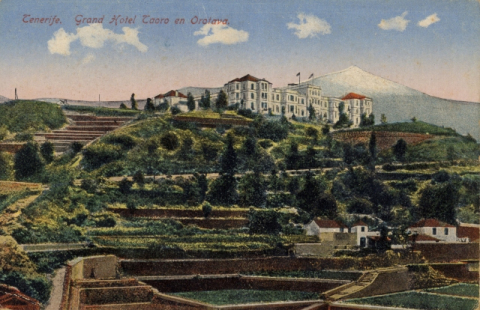The first carnival parade in Puerto de la Cruz
There were six magnificent chariots, invented with exquisite imagination. There were groups
playing percussion instruments and singing Canary Island folk songs. There were ladies
and gentlemen dressed like seventeenth century aristocrats, mounted on a brigade
of horses. They all sailed passively along the dusty lanes and into the cobbled streets
of the old port. It was the beginnings of what was to become a tradition and it
happened just over a century ago.
It was February 1910, in fact, and almost every inhabitant in what was then a busy trading
port watched in amazement and delight as a brilliant spectacle of two thousand
participants from all over the Orotava valley took part in what was the first
ever carnival parade to be held in Puerto de la Cruz. It was the birth of what
has become a famous, colourful, noisy, joyous, popular, carnival festival.
Most of those who led the parade were members of wealthy families in the
Orotava Valley. A good number were from the British and other foreign
communities. The initiative came from the recently constituted Tourism
Committee and the owner of a local newspaper called Arautápala, a
well-travelled gentleman who had witnessed a similar event at Nice on the
French Riviera.
The six chariots, one of which was designed by local artist and
photographer, Marcos Baeza, comprised one of Columbus’s ships, a Viking
longboat manned by members of the British community, a Zeppelin airship with an
elegant crew of German residents, a Swiss country scene, a tray of fruit
and vegetables and another one depicting a colourful basket of island flowers.
The Viking longboat manned by British residents in 1910
(note the Martianez cliffs behind)
The chariots representing ships almost certainly stemmed from original Roman traditions. Whether modern carnival revellers wish to
believe it or not, the word carnival may not only have its origins in the Latin carnem levare, the abandoning of meat for Lent.
Instead, carnivals may owe their origins much more to the
satirical parades in ancient Rome when Bacchus, the God of Wine, permitted
disguises to hide immoral public exhibition, when the God’s personal priest
led the parade on a ship mounted upon wheels. His vessel was called the carrus
navalis, the naval chariot.
Others suggest the word carnival actually derives from another Roman festival, navigium isidis to honour Goddess Isis, navigium being th Latin for ship.
The Navigium Isidis procession in Rome
(by American orientalist artist Frederick Arthus Bridgman in 1902)
Of
course the devotion of man to wearing disguises possibly originates in ancient
Egypt, Greece or even Japan. But it was the flamboyant and inventive Venetian
Italians who introduced masks to hide faces, not just as a source of amusement
but also to avoid recognition and punishment whilst committing a vengeful
crime, participating in a conspiracy or being carnally unfaithful.
The parade in 1910 took the British Vikings, the German Zeppelin, the
Spanish caravel and the rest of the
magnificent procession along the Calle Valois, up the hill as far as the magnificent
Taoro Hotel and then down again to the main square in the heart of the town.
Not
one of these foreign residents and friends could possibly have imagined that just four years later they would be cruelly battling against one another from other kinds of
grey, armoured vessels in a bloody war. Yet, it was there at the Plaza del Charco square where a
great battle took place as participants and onlookers had the most tremendous
fun bombarding each other with flowers and petals. This too became a tradition. The party didn’t end there.
Although the Spanish Civil War and its hungry
aftermath dampened such celebrations, and carnivals were virtually forbidden during
the earlier years of the Franco dictatorship, the splendid ball at the Taoro
Hotel on the eve of the carnival parade became a yearly event. This dance
actually took over from private functions because, prior to that first carnival
parade of 1910, wealthy families in Tenerife, as they would do in Spain and France, had
traditionally celebrated fancy dress dances in their own grand houses.
It was
only after the Orotava Valley began to attract the first foreign, and especially
British travellers, towards the end of the 19th century, that
businessmen realised an annual public carnival would help bring a new form
of lucrative tourism to Puerto de la Cruz. Indeed it did, and if we can learn
from history and the elegance of the old ways, perhaps Puerto’s carnival could once
more help the town revive its once booming tourism industry.
By John Reid Young, author and Canary Island tour guide.
Books by John include:
The Skipping Verger and Other Tales, a collection of short stories.
A Shark in the Bath and Other Stories, a collection of short stories.
El Hombre de La Guancha y Otras Historias, a collection of short stories.
The Journalist, a novel.
For more information, or if you would like to read any of my books, please click on the images to the right of this page.
Please sign up for an occasional newsletter here: https://mailchi.mp/249fadd56fdd/author-john-reid-young
Facebook: https://www.facebook.com/theskippingverger
Twitter: @reidten
Instagram: authorjohnreidyoung
.jpg)


Our best (last) holiday coincided with carnival - absolutely amazing.
ReplyDelete